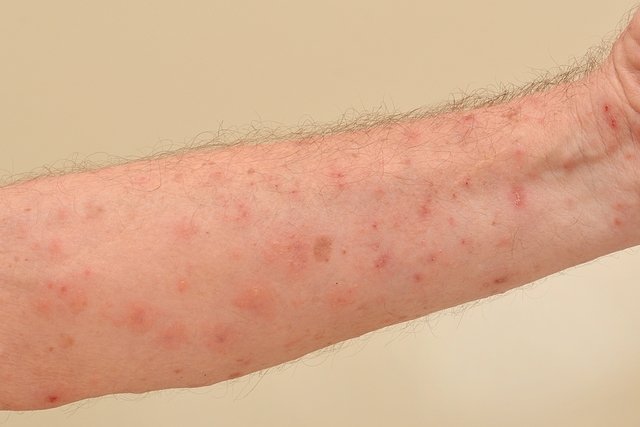Human scabies is an infectious disease caused by the mite Sarcoptes Scabiei, which affects the skin and leads to the appearance of symptoms such as intense itching of the skin that worsens at night and redness.
This disease, also known as scabies, is easily transmitted between people in the same family through sharing clothes, sheets or towels, for example. Although it is also common in animals, scabies cannot be caught from dogs, as the parasites are different.
Human scabies can be cured by following the treatment recommended by the dermatologist, which normally includes the use of medicines such as permethrin or benzoyl, which help eliminate the mite and alleviate the symptoms of scabies.

Human scabies symptoms
The main symptoms of human scabies are:
- Very intense itching of the skin, which worsens at night;
- Small red blisters on the skin;
- Swellings on the skin;
- White lines on the skin, close to the region where the mite is present.
Symptoms of human scabies are most common in areas of skin folds, such as between the fingers and toes, in the armpits, around the waist, breasts or wrists, elbows, groin or buttocks.
When it comes to the first infection, symptoms usually appear within 2 months, however in subsequent cases, symptoms may appear faster, appearing in less than 4 days.
Online symptom test
If you think you may have this disease, select which of the symptoms you are experiencing:
The symptom test is only a guidance tool and does not serve as a diagnosis or replace a consultation with a dermatologist.
How to confirm the diagnosis
The diagnosis of human scabies is made by a dermatologist through evaluation of symptoms, health history and physical examination of the skin.
To confirm the diagnosis, the doctor can perform a dermoscopy exam, as it allows the skin to be assessed in detail and identify the mite, as well as eggs, larvae and feces. Understand how dermoscopy is performed.
Make an appointment with the dermatologist in the region closest to you:
Taking care of your health has never been easier!
How to get human scabies
Human scabies is a very contagious disease that can easily pass between people through direct contact with the skin or contaminated surfaces, such as sheets, mattresses or gym equipment, for example.
Furthermore, the disease can be transmitted even if it is not causing symptoms yet.
Treatment for human scabies
Treatment for human scabies must be guided by a dermatologist and is carried out with scabies remedies such as:
- Permethrin: it is a cream that must be applied to the skin to eliminate the mite and its eggs. Can be used in adults, pregnant women and children over 2 months;
- Crotamiton: can be purchased in the form of a cream or lotion that must be applied daily. Should not be used by pregnant or breastfeeding women;
- Ivermectin: is an antiparasitic medicine in tablet form that helps eliminate the mite. It should not be used by pregnant women, breastfeeding women or children weighing less than 15 kg.
Furthermore, during treatment it is also important to maintain adequate body hygiene and wash all clothes, sheets or towels that have been in direct contact with the skin in hot water. See more scabies remedies.
Home Treatment Options
An excellent natural home remedy to alleviate the symptoms of scabies and complement your treatment is aloe vera gel, which can be applied to affected skin and has properties that reduce itching and can help eliminate mites. Check out other natural remedies for scabies.
Is vinegar good for human scabies?
Vinegar is not normally recommended for treating human scabies, because it is not capable of eliminating the parasite from the skin. Although applying vinegar compresses can sometimes be used to relieve symptoms such as itching, it is not enough to cure scabies. Discover home remedies for itchy skin.
How to prevent
Some precautions are important to prevent the transmission of human scabies, such as:
- Do not share bath towels;
- Avoid sharing unwashed clothes;
- Wash your skin at least once a day;
- Disinfect surfaces shared with several people, such as gym equipment and mats, for example;
- Avoid direct contact with people who live in places with poor hygiene conditions.
In the case of clothes that cannot be washed frequently, a good option is to place them inside a closed plastic bag while they are not being used, as this prevents the mite from being able to feed and eventually being eliminated.
Even when a person has no symptoms but is infected, the disease can be transmitted to other people.
Therefore, if a case of scabies is identified in the family, it is important that everyone who has been in direct contact also undergoes treatment for human scabies.
Bibliography
- PUZA, C. J; SURESH, V. Scabies and Pruritus—A Historical Review. JAMA Dermatology. Vol.154, n.5. 536, 2018
- ELHAGE, Kareem G; CLAIRE, Kayla S; DAVELUY, Steven. Acetic acid and the skin: a review of vinegar in dermatology. Int J Dermatol. Vol.61, n.7. 804-811, 2022
- SUNDERKOTTER, C.; et al. Scabies: Epidemiology, Diagnosis, and Treatment. Dtsch Ärztebl Int. 118. 41; 695-704, 2021
- VASANWALA, F. F.; et al. Management of scabies. Singapore Med J. 60. 6; 281-285, 2019
- RICHARDS, R. N. Scabies: Diagnostic and Therapeutic Update, J Cutan Med Surg. 25.1; 95-101, 2021
- GILSON, R. L.; CRANE, J. S. IN: STATPEARLS (INTERNET). TREASURE ISLAND (FL): STATPEARLS PUBLISHING. Scabies. 2022. Available at: <https://www.ncbi.nlm.nih.gov/books/NBK544306/>. Accessed on Aug 29, 2022
- CDC – CENTERS FOR DISEASE CONTROL AND PREVENTION. Scabies. 2020. Available at: <https://www.cdc.gov/parasites/scabies/gen_info/faqs.html>. Accessed on Aug 29, 2022
- THOMAS, C.; et al. Ectoparasites: Scabies. J Am Acad Dermatol. 82. 3; 533-548, 2020

Sign up for our newsletter and stay up to date with exclusive news
that can transform your routine!
Warning: Undefined array key "title" in /home/storelat/public_html/wp-content/plugins/link-whisper-premium/templates/frontend/related-posts.php on line 12
Warning: Undefined array key "title_tag" in /home/storelat/public_html/wp-content/plugins/link-whisper-premium/templates/frontend/related-posts.php on line 13




